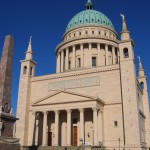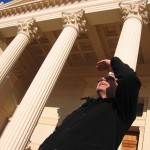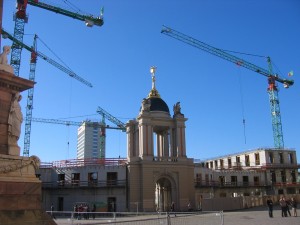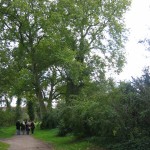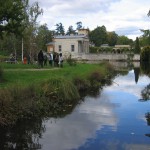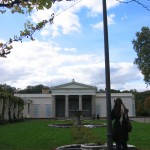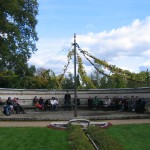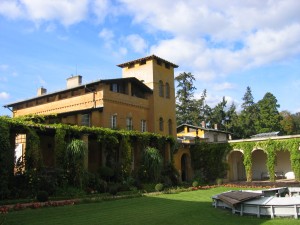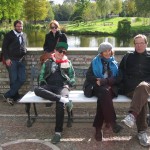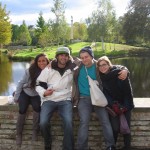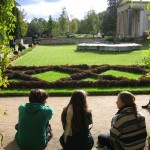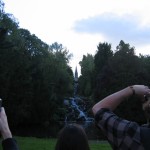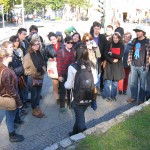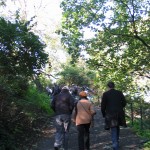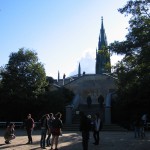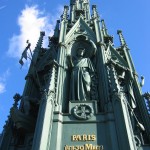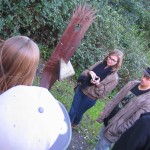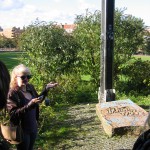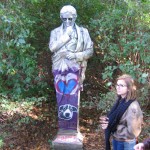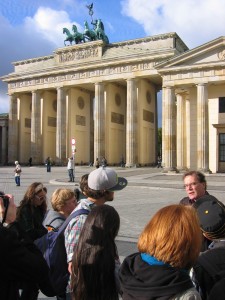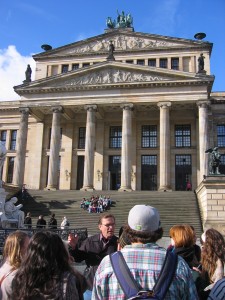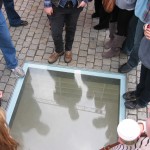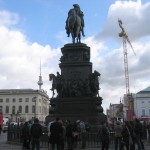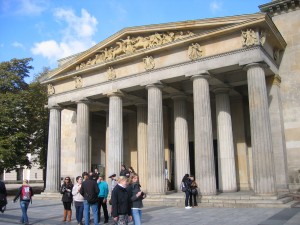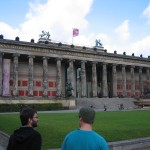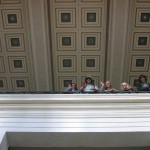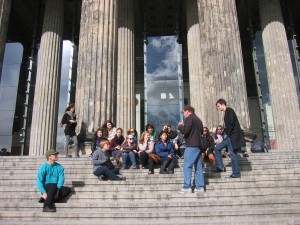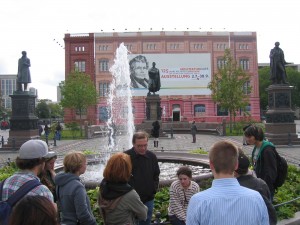A day in Potsdam
Our day trip to Potsdam featured more of our favorite 19th-century designer, Karl Friedrich Schinkel. (You probably think we’re just obsessed with him, but believe us – he truly was great!) We began at the St. Nikolaikirche near the city center. It was begun according to plans by Schinkel, but finished by his student Ludwig Persius.
Berlin isn’t the only city that is rebuilding past monuments – here you can see that Potsdam is also busily rebuilding its royal palace (across from the Nikolaikirche), as a home for the state parliament. Meanwhile, East German buildings on the other side of the square are slated for demolition and replacement.
A trek across Potsdam and through Sanssouci park brought us to another Schinkel site, this one built for a very elite audience – the crown prince.
Schinkel built a tiny summer palace (really the size of a summer home) for the prince, who was a prolific artist and designer himself. Together, they fashioned what the prince referred to as “Siam” – a utopian space filled with rich symbolism, much of which is now lost on those of us without the proper classical education!
Schinkel also designed a house for the court gardener, which later became a billiards room, tea lounge and general garden leisure space for the prince and his friends.
We took some leisure time ourselves – to contemplate the connection between human constructive activity and that of nature, as Schinkel intended – before heading off on our own walks through the rest of Sanssouci park. Next week: Berlin around the turn of the century!
Viktoriapark walk with Annie, Melissa and Rachel
Our students Annie, Melissa and Rachel took us on a tour of Viktoriapark this week. As they explained, the park is home to the “Kreuzberg” (literally “Cross Mountain”) and gives its name to the surrounding neighborhood. The “Kreuz” – really a monument to the wars of liberation against Napoleon – was designed by this week’s featured 19th-century starchitect, Karl Friedrich Schinkel.
It’s a bit of a climb …
… but it’s worth it! There are beautiful views of the city, and of course, a lovely gothic monument to admire as well.
Schinkel isn’t the only artist to have left his mark (whether officially sanctioned or not) on the park. Our guides showed us an artwork commemorating a recent act of sexual violence in the park, another in honor of the uprising of Communist workers in 1953, and one (a spray-paint-covered statue of Heinrich von Kleist) that attests to one of Berlin’s biggest vandalism issues – graffiti. As in the rest of Berlin, Viktoriapark is packed with history, and our tour guides did a lovely job of uncovering some of that for us.
A walk through Schinkel’s Berlin with John Toews
On Wednesday John took us on a tour of Berlin’s historical district, known as Mitte. The focus of our walk was the city as it was in the 19th century, when its inhabitants included some of the leading intellectuals of the time, and the city styled itself as “Athens on the Spree.” We began at the Brandenburg Gate, designed by Carl Gotthard Langhans in the late 18th century as a kind of propylaea leading into Berlin. Karl Friedrich Schinkel had a hand in redesigning the staff held by the goddess of peace who crowns the monument.
We continued on to Schinkel’s Schauspielhaus (now called the Konzerthaus) on the Gendarmenmarkt, a somewhat early commission and an example of the architect’s turn toward neoclassicism.
On the Forum Fridericianum, a square built under Frederick the Great (whose monument you see on the right), there is now a memorial to the book burnings that took place there in the 1930s. The square is home to the former Royal Library, now housing Humboldt University’s law school. Interestingly, we learned that the book burnings were not carried out by Nazi officials, but rather by zealous student party members.
Next stop: the Neue Wache, a guardhouse designed by Schinkel along Unter den Linden. The building has been the site of numerous memorials over the course of the 20th century, including both East German and reunified German commemorations of World War II.
One of Schinkel’s masterpieces, not only of architecture but of urban planning, is the Altes Museum. Sitting across from the site of the royal Prussian palace (not currently extant), the building housed the first true modern museum in Europe. Schinkel designed it to integrate the viewer’s experience of art with that of the urban environment: he provided a viewing platform on the interior of the building, from which visitors could contemplate the royal gardens, palace, and the cityscape beyond.
The tour wrapped up near the site of Schinkel’s Bauakademie – his architectural and design academy. The building is also considered one of his masterworks, and was unfortunately torn down in the post-WWII period. This nylon-covered scaffolding has been here for years, but there’s no money to rebuild it. Its ghostly presence reminds us of the many memories and layers that reside amongst one another in Berlin’s cityscape.
tags
the author
I'm a doctoral student at CUNY Graduate Center. I'm thrilled to be teaching the CHID Berlin program with Prof. John Toews! You can contact me at naraelle [at] gmail.com, or find out more about me at www.naraelle.net.
Blogroll
- Annie Holden's blog
- Cassie Hoeprich's blog
- Dominic Barrera's blog
- Janet Williams's blog
- Mariah Alderete's blog
- Melissa Au's blog
- Robert Hampton's blog
- UW Students Study Abroad Our students Natalie and Cassie are contributing to the official IPE student blog this fall!



